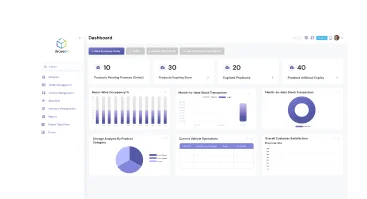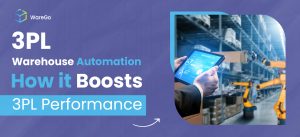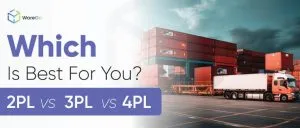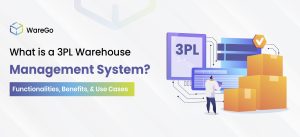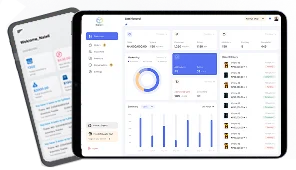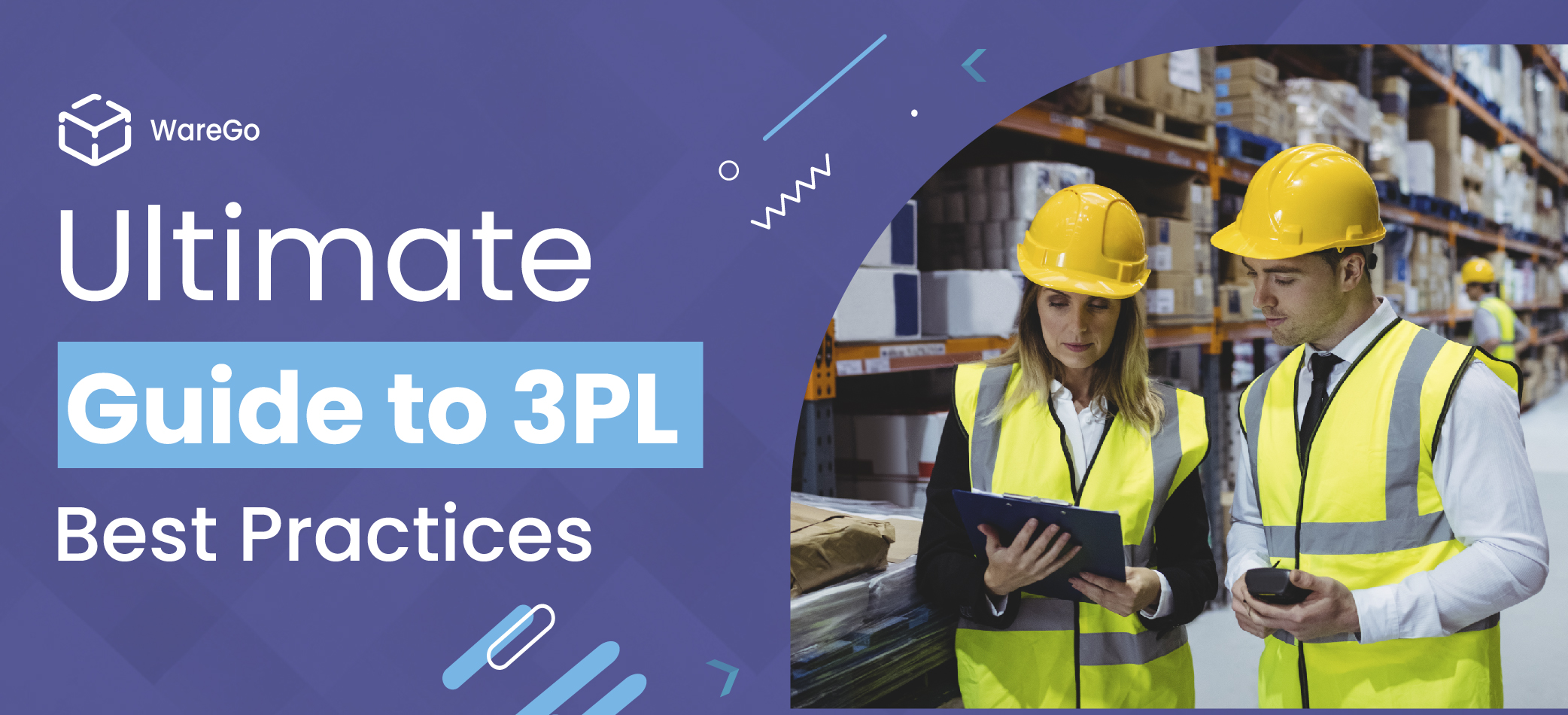
The 3PL industry continues to evolve with the advent of disruptive technologies. Given the rate of technological change, staying ahead of the curve can be challenging. That said, 3PL best practices remain more or less the same. You should know from the get-go that implementing a robust 3PL warehouse management system is by far the most useful best practice that will revolutionize your 3PL performance.
Your free demo can show how our system works wonders for your business.
Start My FREE Demo!We will cover all the essential details needed to improve 3PL performance. We will show you the best practices in logistics that are sure to enhance your supply chain strategy
Table of Contents
3PL Defined
A 3PL service provider provides logistics services to other organizations. Since these are specialists in the field, you can think about outsourcing logistics to the experts to focus on your own business. Due to their expertise and long experience in the logistics sector, 3PL service providers are on top of their game. Hence, you can outsource the logistics function to trusted 3PLs for improved logistics.
3PL service providers take care of the entire supply chain, including distribution, warehousing, and transportation.
3PL Best Practices
While there may be some differences, best practices for 3PL remain rather similar across the board. Here is a list of best practices used by the most renowned 3PL entities:
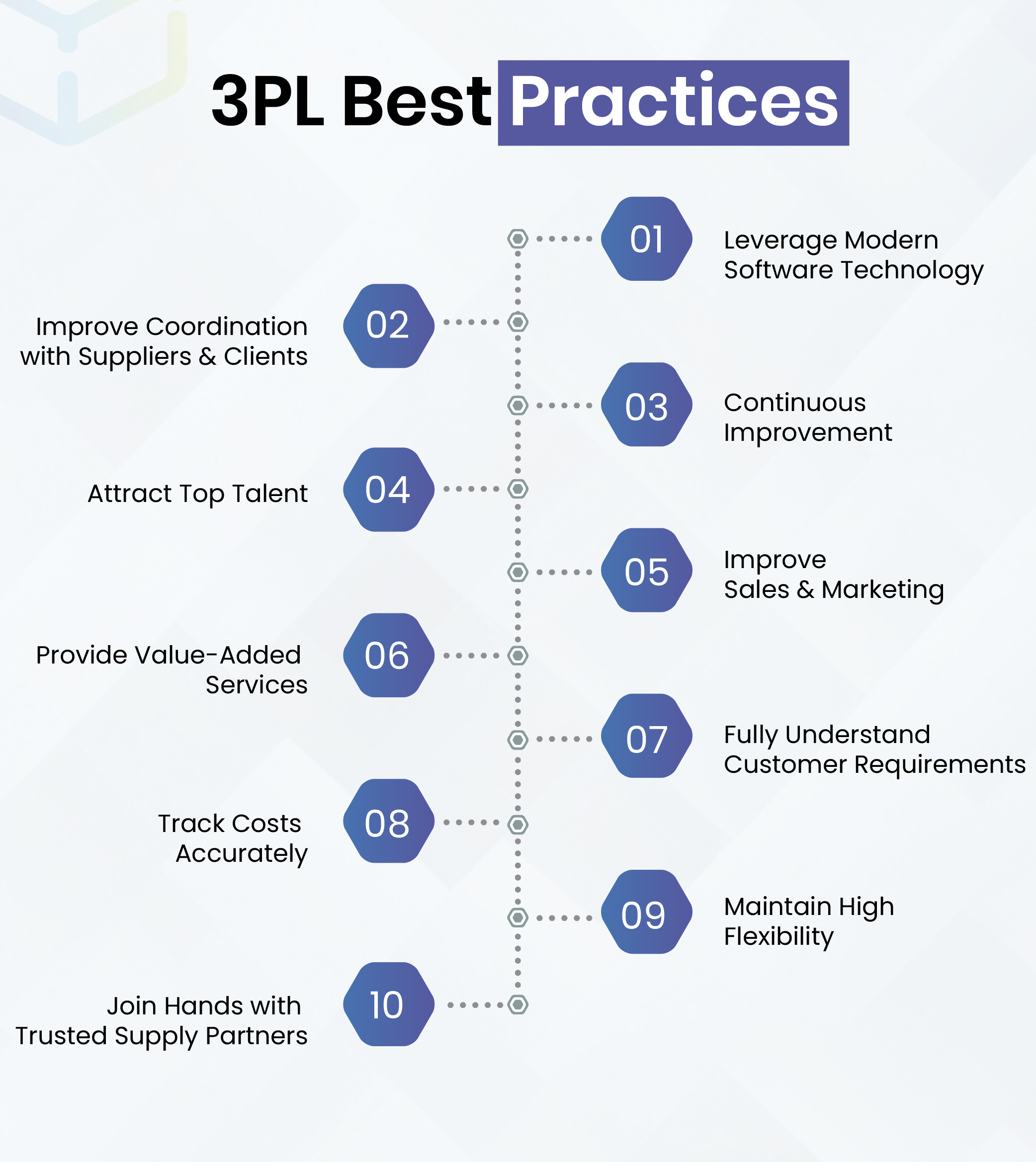
1. Leverage Modern Software Technology
While robotics and cutting-edge hardware get a lot of attention, the fact remains that comprehensive 3PL software is paramount for logistics excellence. Given the complexity of 3PL management, it is virtually impossible to scale, grow, and thrive in the competitive 3PL field without capable software at the core of your operations.
WareGo is the cloud-based 3PL software with complete warehouse, logistics, and supply chain management features. The software is built to simplify multi-location management, making it ideal for 3PL businesses serving multiple clients.
The system can automate, manage, and streamline all inventory processes, like receiving, picking, packing, and dispatch. ABC classification, serialization, slotting, and other proven inventory techniques are built in to expedite operations. Real-time tracking gives you holistic visibility over all parts of your 3PL business.
There are many more useful features besides. In short, WareGo is the all-in-one solution for 3PLs of any scale.
Our friendly experts will be delighted to explain how WareGo can benefit your business.
Start My FREE Consultation!2. Improve Coordination with Suppliers and Clients
You need to provide the best possible service for your clients by going the extra mile. This will maintain customer loyalty and attract new customers as well. Fostering good relations with suppliers is also vital, so you can continue doing business with trusted suppliers who won’t let you down.
Be upfront with your customers about pricing. Make sure your price plans are simple, fully transparent, and have no surprise costs. Clearly communicate service offerings to align client expectations.
You can foster trust by maintaining clear communication with clients and providing transparent pricing.
There is also a need to maintain good relations with trusted suppliers since they can save costs in the long term by delivering according to expectations.
Our 3PL system has full support for shipping carriers, freight, and other logistics services.
Book Your FREE Demo today!3. Continuous Improvement
Since the 3PL sector is constantly evolving, you need to keep up with new technologies to stay relevant. Given the increasing competition, it is vital that you keep improving your services and operations.
There are several ways to do this. You may invest in promising new technologies. Perhaps you could grow your list of service offerings. Whatever you do, you should always seek to enhance operational efficiency and customer service.
Tracking progress is vital for ensuring continuous improvement. You could set goals and specific targets to measure progress. Doing so will let you know the rate at which you are improving.
4. Attract Top Talent
Since high-performance employees are the most valuable asset for any organization, you should take the steps necessary not just to hire but also to retain talented professionals.
Besides offering above-market pay and attractive benefits, you should also provide your employees with career growth opportunities. It is important to cultivate a welcoming, friendly environment where employees will be happy to come to work day after day.
5. Improve Sales and Marketing
No business can get far without sales and marketing done right. This applies in particular to 3PLs, since competition is high and many offer very similar basic services. Proper marketing can help your 3PL business to stand out from the crowd, get noticed, and attract clients.
Investing in sales is also well worth the effort since this function is key to building strong relationships with your customers and converting prospects into loyal customers who keep coming back for more.
You can use all forms of sales and marketing to get the best of both worlds. Inbound and outbound marketing both have their place. So make use of both. Inbound marketing should no doubt be done online via social media, online ads, the web, and so on, to take advantage of the wide reach of the internet.
But at the same time, you should not forget the importance of offline marketing since nothing can replace face-to-face human interaction. For example, you can attend trade shows, business events, seminars, and the like, to reach out to fresh prospects.
6. Provide Value-Added Services
In a crowded field where it can be hard to differentiate your business, value-added services can be the solution. Offer the best services to your clients that will provide real, measurable value for them.
Assembly, packaging, kitting, and reverse logistics (customer returns management) are value-added services that prove to be pure gold for your clients.
Our next-gen system has all that you need to manage your warehouse and inventory with ease.
Contact us for more info!7. Fully Understand Customer Requirements
To achieve 3PL success, you must accurately assess your customers’ needs and find ways to serve them all. You will need to review all key business processes for your clients and understand how their supply chains operate.
You can then develop highly relevant, customized solutions to resolve these pain points and capitalize on available opportunities. Staying informed about industry trends also helps a lot since it lets you know what challenges and opportunities are available. You can then address these to grow your business.
8. Track Costs Accurately
No matter what your business, in the end, it all comes down to financial performance and profit margins. Hence, you must follow all costs and scrupulously document them.
Equally important is accurately allocating costs to your warehouses, transport fleet, labor, and other assets to determine the cost each asset incurs. This information will be instrumental in cutting costs and ensuring high profit margins.
9. Maintain High Flexibility
Your 3PL service will need to be highly flexible and adaptable to fulfill the changing needs of your clients. Flexibility and adaptability are also vital for adopting the latest disruptive technologies that can give you the edge over competitors.
You should be ready to adapt your processes according to customer needs and evolving technologies.
10. Join Hands with Trusted Supply Partners
You should partner with the most reliable supply partners who will ship your deliveries on time. This is vital for maintaining stellar service quality and retaining your customers in the long term.
You will thus have to look out for freight and shipping companies that are known to deliver according to expectations.
The best practices shown above can empower your 3PL business to thrive, grow, and prosper.
By looking for more and more ways to enhance your service quality, you can provide even greater value for your customers. You can start by following the aforementioned best practices.
Bottom Line
Adopting best practices can make your 3PL business more competitive and relevant, even with increasing competition. Deploying a powerful 3PL software solution is one of the best by far. Even if you have a legacy system, you must upgrade to a modern solution like WareGo so that your business thrives.
Our 3PL management system has everything you need to manage your daily operations. Automation features, real-time visibility, accurate demand forecasts, and many other key functions can take your 3PL business to the next level.
Revolutionize your 3PL performance and take it to the next level. Our software lets you do that with real-time tracking, automation, and smart insights.
Contact UsFAQs
What are the best practices for working with a 3PL provider?
Here are the best practices for working with a 3PL service provider:
- Documentation: Draw up an SLA (service level agreement) that defines the scope of service and outlines all deliverables.
- KPIs: Both parties should agree on the performance metrics and their baseline values. These can include turnaround time, inventory accuracy, and order accuracy.
- Escalation Process: Agree on channels for resolving possible disagreements and performance issues.
- Communication: Establish contacts at the operational and strategic levels for high-level coordination. Agree on daily/weekly performance meetings.
- Visibility: The 3PL should use an inventory system that gives you accurate, updated, and complete details on inventory, orders, and shipping status in real-time.
- Analytics: Both parties should study WMS reports and analytics to find actionable insights.
- Cost Audits: Analyze all 3PL service costs and discuss ways to minimize them.
How do I choose the right 3PL for my business?
Here is how to choose the right 3PL for your business:
- Expertise: Select the 3PL service that routinely deals with your industry and inventory type.
- Cost & Benefits: Assess the value being provided for the demanded price. If the 3PL charges more, the benefits should justify the extra cost.
- Outline Goals: Assess why you need the 3PL service (eg, reduced shipping costs, same-day delivery, higher order accuracy, etc).
- Special Requirements: Mention upfront on special management needs, if necessary, for your inventory, like fragile, high-value, or temperature control.
- Services: What value-added services will you need besides warehousing and fulfillment? This could include kitting, assembly, returns processing, etc.
- Order Volume: Provide the 3PL with detailed historical demand patterns, immediate forecasts, and expected order volume in the long term.
- Inquiry: Question the 3PL service on how it can deliver on your goals, requirements, value-added services, and order volume outlined above. Ask for a proven track record in this regard and client testimonials.
Which performance metrics (KPIs) should be used to evaluate a 3PL?
While there are numerous performance metrics (KPIs) to evaluate a 3PL with, here are the most important ones:
- Order Accuracy Rate: Specifies the percentage of customer orders shipped with the right items and documents.
- Shipping Accuracy: Gives the percentage of customers’ orders that are delivered correctly to the right destination.
- Order Cycle Time: The time frame between receiving inventory and shipping the same inventory. Shows how long the 3PL keeps inventory in the warehouse.
- Average Lead Time: how long it takes on average for customers to receive their products after ordering.
- On–Time Delivery Rate: Provides the percentage of orders that are delivered on time to customers.
- Cost Per Order: Total costs divided by total orders shipped. Gives the fulfillment cost per customer order.
- Inventory Turnover Ratio: Cost of goods sold divided by the value of the average inventory level. Shows how quickly inventory is being sold.
How can I ensure seamless technology integration with a 3PL?
Seamless technology integration with a 3PL provides high visibility, prevents errors by eliminating data entry, and saves time. To integrate flawlessly, you must first list all applications you use, like ERP, CRM, OMS, accounts, and others. Then the data flow must be mapped, for example, how data flows from the ecommerce platform to the WMS when there is a sale. The solution you have chosen should facilitate this data flow.
What is the KPI of 3PL?
Here are some important KPIs of 3PLs and what they mean:
- Order Accuracy – How accurately orders are processed.
- Inventory Accuracy – How well actual inventory levels correspond with the inventory levels shown in the WMS.
- On-Time Delivery – The rate at which orders are being delivered on time to customers.
- Order Cycle Time – Time taken by the 3PL to dispatch the item after it is received.
- Cost per Order – The fulfillment cost incurred on average for each customer order.
What is the 3PL strategy?
The 3PL (3rd Party Logistics) strategy is all about outsourcing your order fulfillment, inventory management, and logistics operations to a third party specializing in supply chain management. Given that logistics is complex and time-intensive, it is best left to logistics experts so you are free to focus on your core business.
Since the 3PL service provider specializes in logistics, they may be better suited for your logistics needs. Hence, partnering with a reliable 3PL partner may be a good business decision. With the right 3PL partner, you can ship the right items on time to your customers for a great brand experience.
How to manage 3PL performance?
You can manage 3PL performance by implementing a powerful WMS that extends full 3PL support. You can utilize advanced 3PL support to coordinate closely with your 3PL partner, monitor their performance by following different KPIs in real-time, and so on. WareGo provides complete 3PL support so you can manage the performance of your 3PL partners.
